Global Green Automotive Mobility Market Forecast
- The approximately US$188.7 Bn market for green automotive mobility (2022) slated to rise high up to US$884.4 Bn by 2030
- Green automotive mobility market size projected for a stellar CAGR of 21.3% between 2023 and 2030
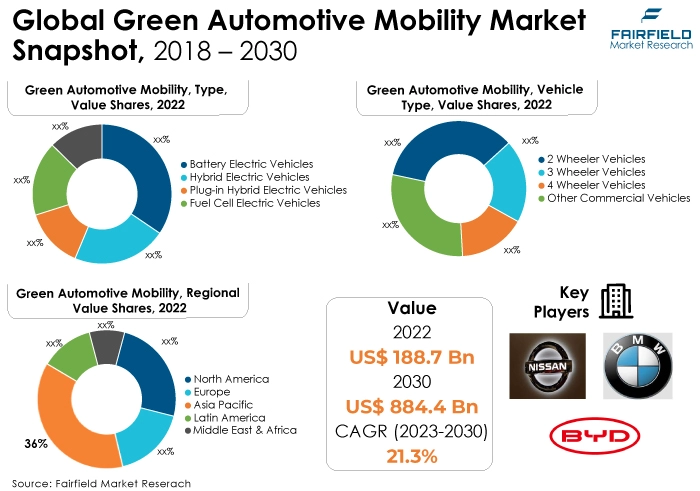
Quick Report Digest
- Per mile driven, each moving vehicle emits an average of one pound of CO2. Taking public transport reduces CO2 emissions by 45% when compared to driving alone, enhancing air quality and lowering air pollution. In the US, carbon dioxide emissions are expected to be reduced by 37 million metric tonnes annually. Six to fourteen million tonnes may be saved if bicycle riding were to increase only slightly.
- An increase in health benefits for locals will come from better air quality. Fewer cases of cancer and respiratory conditions like asthma may be the result. People are also more likely to exercise outside when the air quality is better.
- More roads will need to be built since there will be more traffic, which will cause groundwater contamination and runoff. Fewer automobiles in favour of active transportation, such as bicycles, lead to more bike routes and more environmentally friendly lanes.
- The market for two- and three-wheeled vehicles dominated the green automotive mobility sector in 2022. Given the rising costs of petrol and other fuels, e-bikes and e-scooters are the best and safest options for the majority of people.
- The electric mobility market had a disproportionately large revenue share. The segment is predicted to increase as a result of favourable government initiatives, technological advancements, growing public awareness of performance-based adventure, and rising leisure activity preferences.
- The urban logistics category is highly prevalent in the market for green automotive mobility. Urban logistics might be optimised for efficiency and emissions could be reduced by promoting the use of cleaner fuels.
- The Asia-Pacific region is expected to register for the largest share of the global Green Automotive Mobility Market. The demand for e-scooters in India is expected to rise as more businesses launch shared mobility services and e-commerce businesses choose e-scooters to provide last-mile delivery services.
- Over the course of the projection period, it is anticipated that the regional Green Automotive Mobility Market in Europe will grow due to the rising concerns about vehicle pollution and the supportive government policies to decarbonise transportation.
A Look Back and a Look Forward - Comparative Analysis
Approximately 4.2 billion people reside in urban areas worldwide. New issues are being created by ongoing urbanisation, which calls for modifications to sustainable transportation. The cornerstone of providing decarbonised transportation for people and commodities is zero-emission electromobility. It is a crucial approach to lessen the impact of transportation on the environment.
Players are creating technical solutions for cutting-edge charging infrastructure, the efficient generation and use of renewable energies, and the potential of green hydrogen as part of their continued efforts to support green automotive mobility.
Massive habitat degradation has had an impact on several industries over the past few decades, including pesticides, power, and transportation. As a result, there is a fresh, expanding need for cars. The global green automotive mobility sector will thrive by stealing market share currently controlled by conventional fuel-guzzlers.
Light vehicles, trucks, airplanes, ships, trains, and the infrastructure they support will contribute the third-fastest-growing share of global CO2 emissions by 2030. They currently account for almost one-fourth of all emissions produced globally.
Passenger cars and buses account for around half of the emissions produced by roads, which account for nearly 75% of all emissions associated with global transportation. Rigid decarbonisation is the answer because electromobility is its main tenet and is fueled by green energy from renewable sources.
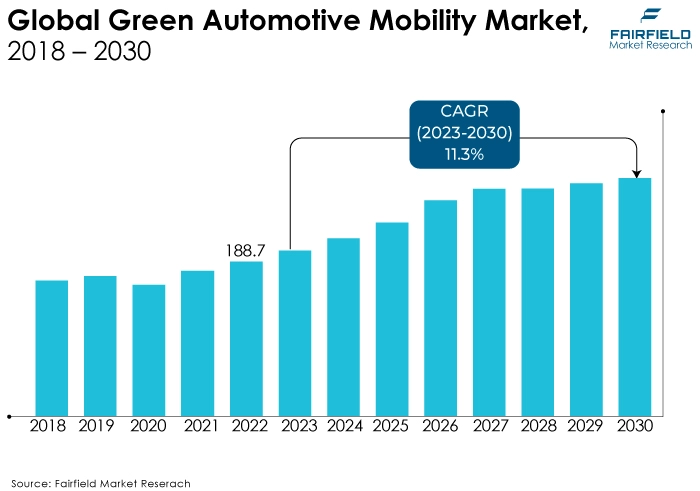
Key Growth Determinants
- Decreasing Prices of Li-ion Cells
The Indian government announced the continuance of the exemption from customs duties on the import of lithium-ion batteries and the exemptions from customs duties for the import of capital goods and machinery for the production of lithium-ion batteries in India.
Additionally, the recent discovery of Li-ion mines in India will boost the country's access to Li-ion batteries and lessen its reliance on imports. With this, the price of Li-ion batteries, which make up close to 60% of the total cost of an EV, will decline over the following several years, further lowering the investment required to buy one.
- Ballooning EV Industry
The electric vehicle (EV) market is still growing quickly on a global scale. Regional performance varies, though, with some EV markets moving closer to becoming mainstream while others are stuck in neutral. Globally speaking, EV sales volumes are growing to the point where they can generate sizable profit margins for well-positioned suppliers and other upstream participants.
Global EV sales increased to almost two million units in 2018; this is a 63 percent year-over-year gain and a significantly greater rate than in previous years. In addition, due in large part to Tesla's Model 3's impressive sales performance, the US market for EVs nearly doubled to 360,000 units. The best-selling EV in the US in 2018 was Tesla's Model 3, which the company sold 140,000 of.
- Favourable Government Initiatives
Governments from all over the world have developed several regulations to boost the market adoption of electric mobility. For instance, the government of India has set a target of 30% vehicle electrification by 2030, according to Invest India, a national facilitation and investment agency.
In addition, the successful commissioning of solar-powered electric car chargers has made the Delhi-Chandigarh route the first road in the nation to be made EV-friendly. Bharat Heavy Electricals Limited (BHEL) created an environmentally friendly network of stations by the guidelines established by the Indian Ministry of Heavy Industries. Strong government measures, carried out by several implementing agencies, have sped up the construction of public EV charging infrastructure.
Major Growth Barriers
- Yet Probihitive EV Costs
The cost of EVs and the infrastructure required to power them is the biggest barrier to the adoption of electric vehicles. To sustainably develop the business from an environmental footprint and economic viewpoint, the sheer amount of material needed to make and power today's first-generation EVs must be decreased.
Without removing components and cutting costs, the EV charging sector of today will not be able to support itself and meet societal demands.
- Power Grid Limitations
The need to expand the power system to handle the rising electricity demand from EVs is one of the main obstacles. The design, approval, and construction of new grid infrastructure can take ten years or more.
According to current estimates, the grid would need to triple in size to handle additional load, including that from EVs. The development of incentives, subsidies, and new regulatory frameworks must go swiftly if the grid is to expand and become widely accessible for EVs.
Key Trends and Opportunities to Look at
- Alternative Fuels
Utilizing alternative fuels, which have a lower carbon intensity and environmental impact than traditional fuels, is another option to make transportation more environmentally friendly. Biofuels, hydrogen, natural gas, and synthetic fuels are a few of these fuels. Fuel cells, which generate energy and water as byproducts, can be powered by hydrogen.
Natural gas may be compressed or liquefied for transportation and burns more cleanly than other fossil fuels. Synthetic fuels can imitate the characteristics of traditional fuels and are made synthetically from carbon dioxide and hydrogen.
- Smart Mobility
Smart mobility, which is a trend in green automotive mobility, is the use of data and digital technologies to maximise the effectiveness and ease of transport networks. Intelligent traffic management, self-driving cars, ride-sharing, micromobility, and multimodal transportation are just a few examples of the numerous components of smart mobility.
In addition to reducing traffic, pollutants, accidents, and travel time, smart mobility can also enhance accessibility, cost, and user experience.
- Enhanced Powertrain Concepts
Electric motor technology is improving over time, enabling silent operations and reducing gearbox losses. This guarantees the vehicles' maximum power delivery and enhanced range.
Manufacturers of batteries are now switching from 18,000 to 21,000 cells since it allows them to fit more energy into the same volume capacity. As a result, the car may give a greater range because the battery capacity will increase while taking up the same amount of space.
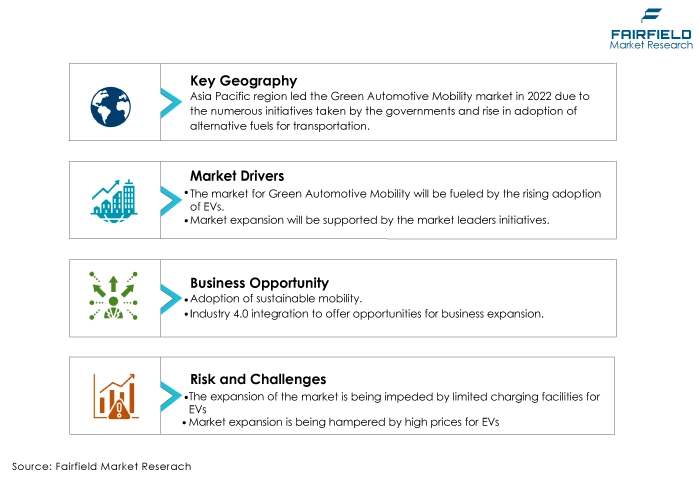
How Does the Regulatory Scenario Shape this Industry?
Over the last three years, the world has understood the need to save the environment by curbing carbon emissions and moving towards green automotive mobility. This has led to an increase in initiatives on the part of governments across various countries to drive the use of green transport. For instance, with a significant emphasis on EVs, India has recently emerged as a pioneer in the sustainable transportation revolution.
The EV industry has been greatly helped by the government's proactive actions, which have resulted in higher sales and a strong startup ecosystem. The electric two-wheeler industry is anticipated to grow to 22 million units by 2030, accounting for 80% of the whole market. In 2030, sales of EV four-wheelers are expected to surpass 900,000 units, according to the Blume EV Primer 2.0 research. EV three-wheeler sales are anticipated to reach 85% penetration.
Fairfield’s Ranking Board
Top Segments
- Electric Mobility Category Dominant
The electric mobility segment dominated the market in 2022. The segment is anticipated to develop as a result of positive government initiatives, rising interest in performance-based adventure, and rising leisure activity preferences. For instance, an Indian e-mobility business named VAAN Electric Moto Pvt Ltd introduced the Urbansport electric bicycle to the nation in January 2023. The e-bike comes in two different models: Urbansport and Urbansport Pro.
Furthermore, the hybrid electric vehicle category is projected to experience the fastest market growth. The popularity and uptake of hybrid vehicles have impressively increased throughout the world. These vehicles combine the advantages of electric power and conventional internal combustion engines, resulting in a more environmentally friendly option that uses less gasoline and emits fewer pollutants.
- Two and Three Wheelers Will Surge Ahead
The sector that currently generates the most revenue in this industry is two and three wheels. E-bikes and e-scooters are the safest and best alternatives for the majority of people in light of the escalating costs of petrol and other fuels. Several automakers are currently entering the market for electric automobiles. This is the reason why the price of e-bikes and e-scooters is decreasing every day.
The passenger vehicle category is anticipated to grow substantially throughout the projected period. The demand for passenger vehicles is growing with the rising population and expanding automobile industry.
Additionally, leading players in the market are also making initiatives which is further expediting the segmental growth. For instance, in August 2023, Tata Passenger Electric Mobility introduced the latest brand for launching ten new battery EVs TATA.ev.
Regional Frontrunners
Asia Pacific Contributes the Largest Share
The Asia Pacific green automotive mobility industry is expanding as a result of rising rules and regulations governing vehicle emissions, increased demand for fuel-efficient, high-performance, and low-emission vehicles, falling battery prices, and rising fuel prices.
To offer its B2B partners a variety of aftermarket services, including insurance (renewals, claims, and sales), roadside assistance, and doorstep/hub-based preventive & and periodic maintenance, Hero Electric, an Indian e-scooter company, announced a partnership with Readily Mobility in September 2022.
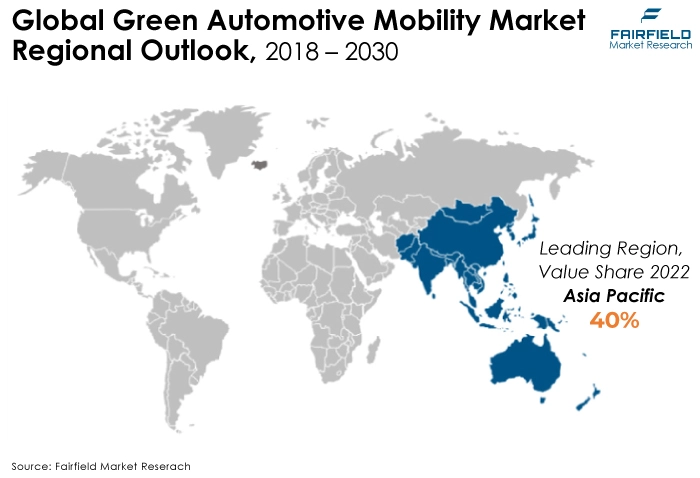
Europe
Over the course of the projected period, the green automotive mobility market in Europe is anticipated to have a sizable CAGR. In Europe, the regional electric mobility market is anticipated to increase over the forecast period as a result of rising concerns about vehicle pollution and encouraging government programs to decarbonise transportation.
The European Commission signed a contract in October 2022 guaranteeing that all newly registered cars and vans in Europe will be emission-free by 2035. As a first step towards zero emissions, the new CO2 laws will also mandate that new vans and cars lower their average emissions by 50% and 55%, respectively, by 2030. These elements are anticipated to support the market's overall expansion in Europe.
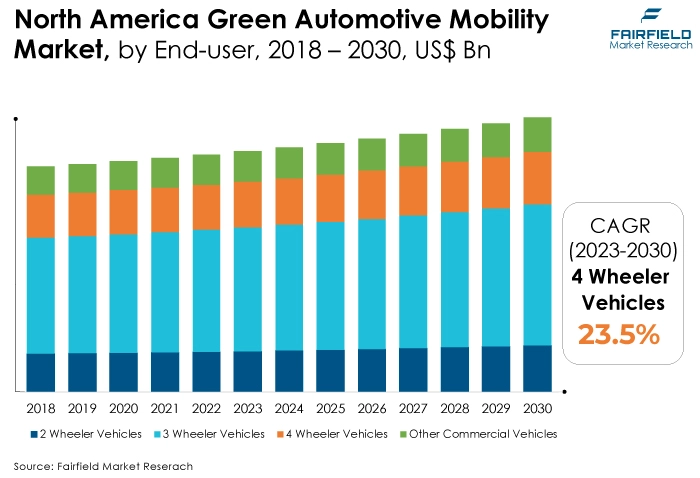
Fairfield’s Competitive Landscape Analysis
The global green automotive mobility market is a consolidated market with fewer major players present across the globe. The key players are introducing new products as well as working on the distribution channels to enhance their worldwide presence. Moreover, Fairfield Market Research is expecting the market to witness more consolidation over the coming years.
Who are the Leaders in Global Green Automotive Mobility Space?
- BMW
- BYD
- Tesla
- Daimler AG
- Nissan
- Engie
- Ford Motors Company
- Kia Motors Corp.
- General Motors
- Volkswagen
- Hyundai Motor Company
- Maruti
- TATA Motors Limited
- Toyota
- Volvo Car Corp.
Significant Company Developments
Partnerships, and Integrations
- May 2023: To hasten its partners' transition to sustainable mobility, Uber has announced agreements with several electric vehicle manufacturers and other organisations in India.
- August 2023: The strategic alliance between Altigreen and Mufin Green Finance has been proudly announced. This alliance intends to promote Green Automotive Mobility options across the globe and quicken the uptake of environmentally friendly transport.
- February 2023: By building a larger new office in Gurugram, Magenta Mobility, a domestic integrated electric mobility, and charging solutions provider, announced its development in North India.
Government Initiatives
- August 2023: The Union Cabinet authorised the "PM-eBus Sewa" program, which will offer 10,000 electric buses to 169 cities using the public-private partnership (PPP) model, to promote Green Automotive Mobility.
- December 2021: The European Commission has proposed four recommendations that will update the transport infrastructure of the EU to promote the shift to cleaner, and smarter mobility, in line with the goals of the European Green DealEN.
An Expert’s Eye
Demand and Future Growth
As per Fairfield’s Analysis, a world that is changing quickly calls for less reliance on traditional energy sources, less pollution, and greater usage of organic products. This planet is undergoing some significant changes as a result of problems like global warming and coral reef degradation. Going green is necessary right now since developing countries have promised to achieve it by 2070.
Additionally, to address the issue of climate change in emissions, the policy of promoting green automotive mobility also directly addresses the air and noise pollution that is brought on by transportation. While India and other developing nations have vowed to achieve this goal by 2070, developed countries like the United States, and England have set a target of reaching zero emissions by 2050.
Supply Side of the Market
According to our analysis, the automotive industry largely affects the green automotive mobility market. This is due to its direct impact on the environment as a whole. With population expansion among countries such as India, China, and others the demand for vehicles is rising which in turn is creating more and more air and noise pollution. For instance, India produced a total of 22.9 million automobiles between April 2021 and March 2022, spanning a range of categories including passenger, commercial, and other vehicles.
However, various manufacturers are coming up with initiatives to increase the production of electric vehicles which can aid in the expansion of the green automotive mobility market. For instance, in February 2022, To meet the rising demand for EVs both domestically and abroad, Tesla intends to construct a second EV manufacturing site in China. Tesla intends to build a second facility close to its current production in Shanghai's Lingang free trade zone to raise capacity in China to at least 1 million vehicles annually shortly.
Global Green Automotive Mobility Space is Segmented as Below:
By Type:
- Battery Electric Vehicles
- Hybrid Electric Vehicles
- Plug-in Hybrid Electric Vehicles
- Fuel Cell Electric Vehicles
- Others
By Vehicle Type:
- 2 Wheeler Vehicles
- 3 Wheeler Vehicles
- 4 Wheeler Vehicles
- Other Commercial Vehicles
By Geographic Coverage:
- North America
- U.S.
- Canada
- Europe
- Germany
- U.K.
- France
- Italy
- Turkey
- Russia
- Rest of Europe
- Asia Pacific
- China
- Japan
- South Korea
- India
- Southeast Asia
- Rest of Asia Pacific
- Latin America
- Brazil
- Mexico
- Argentina
- Rest of Latin America
- Middle East & Africa
- GCC
- South Africa
- Egypt
- Nigeria
- Rest of the Middle East & and Africa
1. Executive Summary
1.1. Global Green Automotive Mobility Market Snapshot
1.2. Future Projections
1.3. Key Market Trends
1.4. Regional Snapshot, by Value, 2022
1.5. Analyst Recommendations
2. Market Overview
2.1. Market Definitions and Segmentations
2.2. Market Battery Electric Vehicles
2.2.1. Drivers
2.2.2. Restraints
2.2.3. Market Opportunities
2.3. Value Chain Analysis
2.4. Porter’s Five Forces Analysis
2.5. Covid-19 Impact Analysis
2.5.1. Supply
2.5.2. Demand
2.6. Impact of Ukraine-Russia Conflict
2.7. Economic Overview
2.7.1. World Economic Projections
2.8. PESTLE Analysis
3. Global Green Automotive Mobility Market Outlook, 2018 - 2030
3.1. Global Green Automotive Mobility Market Outlook, by Type, Value (US$ Bn), 2018 - 2030
3.1.1. Key Highlights
3.1.1.1. Battery Electric Vehicles
3.1.1.2. Hybrid Electric Vehicles
3.1.1.3. Plug-in Hybrid Electric Vehicles
3.1.1.4. Fuel Cell Electric Vehicles
3.1.1.5. Others
3.2. Global Green Automotive Mobility Market Outlook, by Vehicle Type, Value (US$ Bn), 2018 - 2030
3.2.1. Key Highlights
3.2.1.1. 2 Wheeler Vehicles
3.2.1.2. 3 Wheeler Vehicles
3.2.1.3. 4 Wheeler Vehicles
3.2.1.4. Other Commercial Vehicles
3.3. Global Green Automotive Mobility Market Outlook, by Region, Value (US$ Bn), 2018 - 2030
3.3.1. Key Highlights
3.3.1.1. North America
3.3.1.2. Europe
3.3.1.3. Asia Pacific
3.3.1.4. Latin America
3.3.1.5. Middle East & Africa
4. North America Green Automotive Mobility Market Outlook, 2018 - 2030
4.1. North America Green Automotive Mobility Market Outlook, by Type, Value (US$ Bn), 2018 - 2030
4.1.1. Key Highlights
4.1.1.1. Battery Electric Vehicles
4.1.1.2. Hybrid Electric Vehicles
4.1.1.3. Plug-in Hybrid Electric Vehicles
4.1.1.4. Fuel Cell Electric Vehicles
4.1.1.5. Others
4.2. North America Green Automotive Mobility Market Outlook, by Vehicle Type, Value (US$ Bn), 2018 - 2030
4.2.1. Key Highlights
4.2.1.1. 2 Wheeler Vehicles
4.2.1.2. 3 Wheeler Vehicles
4.2.1.3. 4 Wheeler Vehicles
4.2.1.4. Other Commercial Vehicles
4.3. North America Green Automotive Mobility Market Outlook, by Country, Value (US$ Bn), 2018 - 2030
4.3.1. Key Highlights
4.3.1.1. U.S. Green Automotive Mobility Market by Type, Value (US$ Bn), 2018 - 2030
4.3.1.2. U.S. Green Automotive Mobility Market Vehicle Type, Value (US$ Bn), 2018 - 2030
4.3.1.3. U.S. Green Automotive Mobility Market Application, Value (US$ Bn), 2018 - 2030
4.3.1.4. Canada Green Automotive Mobility Market by Type, Value (US$ Bn), 2018 - 2030
4.3.1.5. Canada Green Automotive Mobility Market Vehicle Type, Value (US$ Bn), 2018 - 2030
4.3.1.6. Canada Green Automotive Mobility Market Application, Value (US$ Bn), 2018 - 2030
4.3.2. BPS Analysis/Market Attractiveness Analysis
5. Europe Green Automotive Mobility Market Outlook, 2018 - 2030
5.1. Europe Green Automotive Mobility Market Outlook, by Type, Value (US$ Bn), 2018 - 2030
5.1.1. Key Highlights
5.1.1.1. Battery Electric Vehicles
5.1.1.2. Hybrid Electric Vehicles
5.1.1.3. Plug-in Hybrid Electric Vehicles
5.1.1.4. Fuel Cell Electric Vehicles
5.1.1.5. Others
5.2. Europe Green Automotive Mobility Market Outlook, by Vehicle Type, Value (US$ Bn), 2018 - 2030
5.2.1. Key Highlights
5.2.1.1. 2 Wheeler Vehicles
5.2.1.2. 3 Wheeler Vehicles
5.2.1.3. 4 Wheeler Vehicles
5.2.1.4. Other Commercial Vehicles
5.3. Europe Green Automotive Mobility Market Outlook, by Country, Value (US$ Bn), 2018 - 2030
5.3.1. Key Highlights
5.3.1.1. Germany Green Automotive Mobility Market by Type, Value (US$ Bn), 2018 - 2030
5.3.1.2. Germany Green Automotive Mobility Market Vehicle Type, Value (US$ Bn), 2018 - 2030
5.3.1.3. Germany Green Automotive Mobility Market Application, Value (US$ Bn), 2018 - 2030
5.3.1.4. U.K. Green Automotive Mobility Market by Type, Value (US$ Bn), 2018 - 2030
5.3.1.5. U.K. Green Automotive Mobility Market Vehicle Type, Value (US$ Bn), 2018 - 2030
5.3.1.6. U.K. Green Automotive Mobility Market Application, Value (US$ Bn), 2018 - 2030
5.3.1.7. France Green Automotive Mobility Market by Type, Value (US$ Bn), 2018 - 2030
5.3.1.8. France Green Automotive Mobility Market Vehicle Type, Value (US$ Bn), 2018 - 2030
5.3.1.9. France Green Automotive Mobility Market Application, Value (US$ Bn), 2018 - 2030
5.3.1.10. Italy Green Automotive Mobility Market by Type, Value (US$ Bn), 2018 - 2030
5.3.1.11. Italy Green Automotive Mobility Market Vehicle Type, Value (US$ Bn), 2018 - 2030
5.3.1.12. Italy Green Automotive Mobility Market Application, Value (US$ Bn), 2018 - 2030
5.3.1.13. Turkey Green Automotive Mobility Market by Type, Value (US$ Bn), 2018 - 2030
5.3.1.14. Turkey Green Automotive Mobility Market Vehicle Type, Value (US$ Bn), 2018 - 2030
5.3.1.15. Turkey Green Automotive Mobility Market Application, Value (US$ Bn), 2018 - 2030
5.3.1.16. Russia Green Automotive Mobility Market by Type, Value (US$ Bn), 2018 - 2030
5.3.1.17. Russia Green Automotive Mobility Market Vehicle Type, Value (US$ Bn), 2018 - 2030
5.3.1.18. Russia Green Automotive Mobility Market Application, Value (US$ Bn), 2018 - 2030
5.3.1.19. Rest of Europe Green Automotive Mobility Market by Type, Value (US$ Bn), 2018 - 2030
5.3.1.20. Rest of Europe Green Automotive Mobility Market Vehicle Type, Value (US$ Bn), 2018 - 2030
5.3.1.21. Rest of Europe Green Automotive Mobility Market Application, Value (US$ Bn), 2018 - 2030
5.3.2. BPS Analysis/Market Attractiveness Analysis
6. Asia Pacific Green Automotive Mobility Market Outlook, 2018 - 2030
6.1. Asia Pacific Green Automotive Mobility Market Outlook, by Type, Value (US$ Bn), 2018 - 2030
6.1.1. Key Highlights
6.1.1.1. Battery Electric Vehicles
6.1.1.2. Hybrid Electric Vehicles
6.1.1.3. Plug-in Hybrid Electric Vehicles
6.1.1.4. Fuel Cell Electric Vehicles
6.1.1.5. Others
6.2. Asia Pacific Green Automotive Mobility Market Outlook, by Vehicle Type, Value (US$ Bn), 2018 - 2030
6.2.1. Key Highlights
6.2.1.1. 2 Wheeler Vehicles
6.2.1.2. 3 Wheeler Vehicles
6.2.1.3. 4 Wheeler Vehicles
6.2.1.4. Other Commercial Vehicles
6.3. Asia Pacific Green Automotive Mobility Market Outlook, by Country, Value (US$ Bn), 2018 - 2030
6.3.1. Key Highlights
6.3.1.1. China Green Automotive Mobility Market by Type, Value (US$ Bn), 2018 - 2030
6.3.1.2. China Green Automotive Mobility Market Vehicle Type, Value (US$ Bn), 2018 - 2030
6.3.1.3. China Green Automotive Mobility Market Application, Value (US$ Bn), 2018 - 2030
6.3.1.4. Japan Green Automotive Mobility Market by Type, Value (US$ Bn), 2018 - 2030
6.3.1.5. Japan Green Automotive Mobility Market Vehicle Type, Value (US$ Bn), 2018 - 2030
6.3.1.6. Japan Green Automotive Mobility Market Application, Value (US$ Bn), 2018 - 2030
6.3.1.7. South Korea Green Automotive Mobility Market by Type, Value (US$ Bn), 2018 - 2030
6.3.1.8. South Korea Green Automotive Mobility Market Vehicle Type, Value (US$ Bn), 2018 - 2030
6.3.1.9. South Korea Green Automotive Mobility Market Application, Value (US$ Bn), 2018 - 2030
6.3.1.10. India Green Automotive Mobility Market by Type, Value (US$ Bn), 2018 - 2030
6.3.1.11. India Green Automotive Mobility Market Vehicle Type, Value (US$ Bn), 2018 - 2030
6.3.1.12. India Green Automotive Mobility Market Application, Value (US$ Bn), 2018 - 2030
6.3.1.13. Southeast Asia Green Automotive Mobility Market by Type, Value (US$ Bn), 2018 - 2030
6.3.1.14. Southeast Asia Green Automotive Mobility Market Vehicle Type, Value (US$ Bn), 2018 - 2030
6.3.1.15. Southeast Asia Green Automotive Mobility Market Application, Value (US$ Bn), 2018 - 2030
6.3.1.16. Rest of Asia Pacific Green Automotive Mobility Market by Type, Value (US$ Bn), 2018 - 2030
6.3.1.17. Rest of Asia Pacific Green Automotive Mobility Market Vehicle Type, Value (US$ Bn), 2018 - 2030
6.3.1.18. Rest of Asia Pacific Green Automotive Mobility Market Application, Value (US$ Bn), 2018 - 2030
6.3.2. BPS Analysis/Market Attractiveness Analysis
7. Latin America Green Automotive Mobility Market Outlook, 2018 - 2030
7.1. Latin America Green Automotive Mobility Market Outlook, by Type, Value (US$ Bn), 2018 - 2030
7.1.1. Key Highlights
7.1.1.1. Battery Electric Vehicles
7.1.1.2. Hybrid Electric Vehicles
7.1.1.3. Plug-in Hybrid Electric Vehicles
7.1.1.4. Fuel Cell Electric Vehicles
7.1.1.5. Others
7.2. Latin America Green Automotive Mobility Market Outlook, by Vehicle Type, Value (US$ Bn), 2018 - 2030
7.2.1. Key Highlights
7.2.1.1. 2 Wheeler Vehicles
7.2.1.2. 3 Wheeler Vehicles
7.2.1.3. 4 Wheeler Vehicles
7.2.1.4. Other Commercial Vehicles
7.3. Latin America Green Automotive Mobility Market Outlook, by Country, Value (US$ Bn), 2018 - 2030
7.3.1. Key Highlights
7.3.1.1. Brazil Green Automotive Mobility Market by Type, Value (US$ Bn), 2018 - 2030
7.3.1.2. Brazil Green Automotive Mobility Market Vehicle Type, Value (US$ Bn), 2018 - 2030
7.3.1.3. Brazil Green Automotive Mobility Market Application, Value (US$ Bn), 2018 - 2030
7.3.1.4. Mexico Green Automotive Mobility Market by Type, Value (US$ Bn), 2018 - 2030
7.3.1.5. Mexico Green Automotive Mobility Market Vehicle Type, Value (US$ Bn), 2018 - 2030
7.3.1.6. Mexico Green Automotive Mobility Market Application, Value (US$ Bn), 2018 - 2030
7.3.1.7. Argentina Green Automotive Mobility Market by Type, Value (US$ Bn), 2018 - 2030
7.3.1.8. Argentina Green Automotive Mobility Market Vehicle Type, Value (US$ Bn), 2018 - 2030
7.3.1.9. Argentina Green Automotive Mobility Market Application, Value (US$ Bn), 2018 - 2030
7.3.1.10. Rest of Latin America Green Automotive Mobility Market by Type, Value (US$ Bn), 2018 - 2030
7.3.1.11. Rest of Latin America Green Automotive Mobility Market Vehicle Type, Value (US$ Bn), 2018 - 2030
7.3.1.12. Rest of Latin America Green Automotive Mobility Market Application, Value (US$ Bn), 2018 - 2030
7.3.2. BPS Analysis/Market Attractiveness Analysis
8. Middle East & Africa Green Automotive Mobility Market Outlook, 2018 - 2030
8.1. Middle East & Africa Green Automotive Mobility Market Outlook, by Type, Value (US$ Bn), 2018 - 2030
8.1.1. Key Highlights
8.1.1.1. Battery Electric Vehicles
8.1.1.2. Hybrid Electric Vehicles
8.1.1.3. Plug-in Hybrid Electric Vehicles
8.1.1.4. Fuel Cell Electric Vehicles
8.1.1.5. Others
8.2. Middle East & Africa Green Automotive Mobility Market Outlook, by Vehicle Type, Value (US$ Bn), 2018 - 2030
8.2.1. Key Highlights
8.2.1.1. 2 Wheeler Vehicles
8.2.1.2. 3 Wheeler Vehicles
8.2.1.3. 4 Wheeler Vehicles
8.2.1.4. Other Commercial Vehicles
8.3. Middle East & Africa Green Automotive Mobility Market Outlook, by Country, Value (US$ Bn), 2018 - 2030
8.3.1. Key Highlights
8.3.1.1. GCC Green Automotive Mobility Market by Type, Value (US$ Bn), 2018 - 2030
8.3.1.2. GCC Green Automotive Mobility Market Vehicle Type, Value (US$ Bn), 2018 - 2030
8.3.1.3. GCC Green Automotive Mobility Market Application, Value (US$ Bn), 2018 - 2030
8.3.1.4. South Africa Green Automotive Mobility Market by Type, Value (US$ Bn), 2018 - 2030
8.3.1.5. South Africa Green Automotive Mobility Market Vehicle Type, Value (US$ Bn), 2018 - 2030
8.3.1.6. South Africa Green Automotive Mobility Market Application, Value (US$ Bn), 2018 - 2030
8.3.1.7. Egypt Green Automotive Mobility Market by Type, Value (US$ Bn), 2018 - 2030
8.3.1.8. Egypt Green Automotive Mobility Market Vehicle Type, Value (US$ Bn), 2018 - 2030
8.3.1.9. Egypt Green Automotive Mobility Market Application, Value (US$ Bn), 2018 - 2030
8.3.1.10. Nigeria Green Automotive Mobility Market by Type, Value (US$ Bn), 2018 - 2030
8.3.1.11. Nigeria Green Automotive Mobility Market Vehicle Type, Value (US$ Bn), 2018 - 2030
8.3.1.12. Nigeria Green Automotive Mobility Market Application, Value (US$ Bn), 2018 - 2030
8.3.1.13. Rest of Middle East & Africa Green Automotive Mobility Market by Type, Value (US$ Bn), 2018 - 2030
8.3.1.14. Rest of Middle East & Africa Green Automotive Mobility Market Vehicle Type, Value (US$ Bn), 2018 - 2030
8.3.1.15. Rest of Middle East & Africa Green Automotive Mobility Market Application, Value (US$ Bn), 2018 - 2030
8.3.2. BPS Analysis/Market Attractiveness Analysis
9. Competitive Landscape
9.1. Application vs. Application Heatmap
9.2. Manufacturer vs Application Heatmap
9.3. Company Market Share Analysis, 2022
9.4. Competitive Dashboard
9.5. Company Profiles
9.5.1. BMW
9.5.2. BYD
9.5.2.1. Company Overview
9.5.2.2. Product Portfolio
9.5.2.3. Financial Overview
9.5.2.4. Business Strategies and Development
9.5.3. Tesla
9.5.3.1. Company Overview
9.5.3.2. Product Portfolio
9.5.3.3. Financial Overview
9.5.3.4. Business Strategies and Development
9.5.4. Daimler AG.
9.5.4.1. Company Overview
9.5.4.2. Product Portfolio
9.5.4.3. Financial Overview
9.5.4.4. Business Strategies and Development
9.5.5. Nissan.
9.5.5.1. Company Overview
9.5.5.2. Product Portfolio
9.5.5.3. Financial Overview
9.5.5.4. Business Strategies and Development
9.5.6. Engie
9.5.6.1. Company Overview
9.5.6.2. Product Portfolio
9.5.6.3. Financial Overview
9.5.6.4. Business Strategies and Development
9.5.7. Ford Motors Company.
9.5.7.1. Company Overview
9.5.7.2. Product Portfolio
9.5.7.3. Financial Overview
9.5.7.4. Business Strategies and Development
9.5.8. Kia Motors Corp
9.5.8.1. Company Overview
9.5.8.2. Product Portfolio
9.5.8.3. Financial Overview
9.5.8.4. Business Strategies and Development
9.5.9. General Motors
9.5.9.1. Company Overview
9.5.9.2. Product Portfolio
9.5.9.3. Business Strategies and Development
9.5.10. Volkswagen
9.5.10.1. Company Overview
9.5.10.2. Product Portfolio
9.5.10.3. Financial Overview
9.5.10.4. Business Strategies and Development
9.5.11. Hyundai Motor Company.
9.5.11.1. Company Overview
9.5.11.2. Product Portfolio
9.5.11.3. Financial Overview
9.5.11.4. Business Strategies and Development
9.5.12. Maruti.
9.5.12.1. Company Overview
9.5.12.2. Product Portfolio
9.5.12.3. Financial Overview
9.5.12.4. Business Strategies and Development
9.5.13. TATA Motors Limited
9.5.13.1. Company Overview
9.5.13.2. Product Portfolio
9.5.13.3. Financial Overview
9.5.13.4. Business Strategies and Development
9.5.14. Toyota
9.5.14.1. Company Overview
9.5.14.2. Product Portfolio
9.5.14.3. Financial Overview
9.5.14.4. Business Strategies and Development
9.5.15. Volvo Car Corp
9.5.15.1. Company Overview
9.5.15.2. Product Portfolio
9.5.15.3. Financial Overview
9.5.15.4. Business Strategies and Development
10. Appendix
10.1. Research Methodology
10.2. Report Assumptions
10.3. Acronyms and Abbreviations
|
BASE YEAR |
HISTORICAL DATA |
FORECAST PERIOD |
UNITS |
|||
|
2022 |
|
2018 - 2022 |
2023 - 2030 |
Value: US$ Million |
||
|
REPORT FEATURES |
DETAILS |
|
Type Coverage |
|
|
Vehicle Type Coverage |
|
|
Geographical Coverage |
|
|
Leading Companies |
|
|
Report Highlights |
Key Market Indicators, Macro-micro economic impact analysis, Technological Roadmap, Key Trends, Driver, Restraints, and Future Opportunities & Revenue Pockets, Porter’s 5 Forces Analysis, Historical Trend (2019-2021), Market Estimates and Forecast, Market Dynamics, Industry Trends, Competition Landscape, Category, Region, Country wise Trends & Analysis, COVID-19 Impact Analysis (Demand and Supply Chain) |
